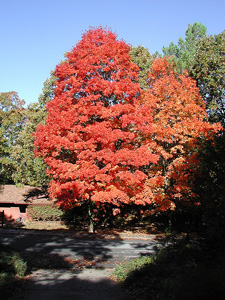Resource Library
Plant of the Week: Fall Color
The University of Arkansas System Division of Agriculture does not promote, support or recommend plants featured in "Plant of the Week." Please consult your local Extension office for plants suitable for your region.
Plant of the Week
Fall Color

The record-breaking drought of 2012 still lingers in Arkansas, but because cooler weather has arrived, its immediate impact is less noticeable. As unlikely as it seems, the terrible summer may actually result in a good fall color display, especially in the Ozarks where oaks predominate.
Deciduous trees ready themselves for fall by moving as much of the mobile nutrient stores from the leaves to the roots and lower portion of the trunk. This starts in September for most species, and by mid-October, a group of specialized cells at the base of the leaf has formed the abscission layer that permits the leaf to detach from the tree. Once the abscission layer has formed, nutrients can no longer be moved from the leaf, and fall color formation begins in earnest.
Fall colors form in plants due to a change in the status of pigments within each cell. There are two broad groups of plant pigments – the plastid pigments and the cytoplasmic pigments but the latter group is not involved in fall color formation. The most important plastid pigment in plants is chlorophyll, which carries out photosynthesis during the growing season. However, the green chlorophyll pigment is not the only pigment contained in the chloroplast, the cellular organelle that houses the chlorophyll molecule.
Each chloroplast also contains various carotenoid pigments – more than 600 have been identified – that produce colors in shades of red or orange (carotene) or of yellow (xanthophylls). These pigments are believed to protect chlorophyll from damage by UV light. During the process of season-end senescence, chlorophyll is broken down and some of its long chain carbohydrates sent to the base of the tree for winter storage. As the chlorophyll breaks down, the remaining carotenoid pigments become visible as shades of red, orange, yellow or combinations of these.
Summertime stress may mean more of the carotene and xanthophyll pigments are laid down so stressful years tend to have good fall color displays. However, the best years for fall color displays occur when a stressful summer is followed by a fall with bright, warm days and cool nights. During these conditions, carbohydrates begin to accumulate in the leaf because the abscission layer prevents them from leaving. In nature’s version of a balancing act some of the carbohydrates are then converted into carotenoid pigments and the colors intensify.
Gloomy, cloudy days and warm nights see less carbohydrate production so color intensity is lessened.
Predicting the peak period for color display is problematic because each species has its own schedule. Sumacs and black gums are amongst the earliest to show color, often starting in late September. Sugar maples usually peak in north Arkansas from mid- to late-October with lots of variability in time of display and shades of red, orange and yellow. Sugar maples are mostly grown from seedlings so genetic variation is great. In the 40 years I have observed the maples in Fayetteville, I’ve seen their peak fall color display pushed back about 10 days due to the effects of global warming.
Red maples, on the other hand, come into their glory around the end of the month. However, because they are clonally propagated trees, they show distinct cultivar characteristics. Autumn Blaze colors two to three weeks before October Glory which is about a week earlier than Autumn Sunset. Japanese maples delay their display well into November.
But to have a really spectacular fall color year the oaks have to do their thing. Oaks show year to year variation but usually peak during the last week of October or the first week of November.
By: Gerald Klingaman, retired
Retired Extension Horticulturist - Ornamentals
Extension News - October 12, 2012
The University of Arkansas System Division of Agriculture does not maintain lists of retail outlets where these plants can be purchased. Please check your local nursery or other retail outlets to ask about the availability of these plants for your growing area.